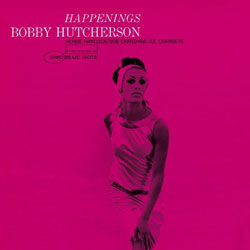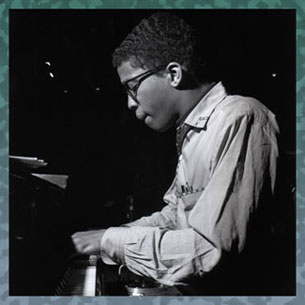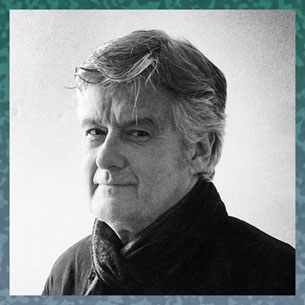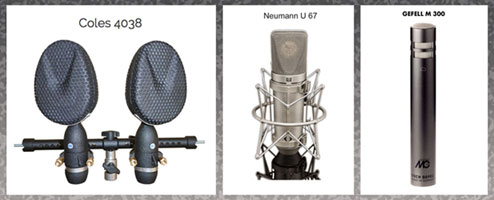

|
Soundclip:
|
| See Steve's Hand-Written Solo
Transcription |
|
Steve Khan's acoustic guitar solo on: "Bouquet"(Bobby Hutcherson) I think that it is safe to say that, virtually everyone who visits these pages would know by now that, Bobby Hutcherson's 1966 album "HAPPENINGS"(Blue Note) has been one of my all-time favorite recordings. The original version of "Bouquet" featured these great players: Herbie Hancock(piano), Bob Cranshaw(ac. bass) and Joe Chambers(drums), but as I was searching the LP bins in West Los Angeles, while attending U.C.L.A.,  I was probably drawn to the album, because I saw that they had interpreted Hancock's "Maiden Voyage." On 2016's "BACKLOG" album, I recorded two other great tunes from this album: " I was probably drawn to the album, because I saw that they had interpreted Hancock's "Maiden Voyage." On 2016's "BACKLOG" album, I recorded two other great tunes from this album: "As my search began for tunes that I wanted to arrange and perform, I returned to "Bouquet" and suddenly realized that it could reimagined as a bolero, but in 3/4. I can't honestly say that I know of any other bolero in the repertoire of Latin music or Latin Jazz that has been performed in 3/4. So, for all of us, we were going to be venturing into new territory. On this performance, I am heard on my Martin MC-28 steel-string acoustic and accompanied by a hauntingly beautiful orchestration by Rob Mounsey. After many discussions, I simply yielded to Rob's harmonic vision of just how to treat this piece, and our collaboration became a work of great beauty. I'm very proud of what we did with this very special piece of music. On this particular guitar, I think that this is my best work since I played it on "Drink Moon Garden" from Rob's solo album "BACK IN THE POOL"(1993), on "Face Value" from "BORROWED TIME"(2007), and even the more aggressive "Rojo" from "BACKLOG"(2016). What I believe gives my approach to playing the acoustic steel-string in a context like this a unique quality is: [1] I use a set of Darco New Yorker Extra-Light Gauge strings. Running from .010 for the high E-string to a .047 for the low E-string. And, [2] and most important of all, is that I replace the G-string with a plain unwound string using a gauge of .017. For me, this gives the instrument an expressive twang to it that I love. It also makes it easier for me to use my vibrato more often, and keep ever closer to the language of the blues, that should exist for any player, but especially for us guitarists. Hutcherson's composition fascinates me, and I suppose that it always will - because I have never seen a lead sheet to it, and my sense is that his original melody has many more long notes than what I first heard him play on his "HAPPENINGS" album. So, not having another resource, I just chose to interpret how he played his own melody both times on the original. I tried to touch upon several of the key moments without being too married to his precise phrasing. For this version, I felt that having the piece fade out would be more in keeping with the dream-like nature we were going to create, and so I invented a series of chord changes that would keep 'the feeling' going, but would still be different and give the tune a fitting send-off. So, with that said, let's take a look at the specifics of the solo. Like so much of the music, the tunes of the mid-'60s, when a particular kind of Modal Jazz was king, "Bouquet" presents a series of dominant 7th(9sus) chords that move in fairly consistent intervals. Beginning with D7(9sus), they go down a m3rd and then up a whole-step, and that movement is repeated. When this sequence arrives at Bb7(9sus), it then moves up a whole-step to C7(9sus), and then down again a m3rd to A7(9sus) before the moment of surprise arrives. Then, in a brilliant contrast, you have a Phrygian sound of Eb/D, or you could view it as Cm9/D, resolving to Dm. It is a wonderful touch, and both Rob and I wanted to treat it as such. My contribution was to add in pizzicato strings playing on the upbeats, while there was a swirling strings pad playing a tremolo, plus Rob's other beautiful touches with harps, celeste, orchestra bells, etc.! This section, like all the others, only last for 4 bars each time, but it is striking. From the rhythm section perspective, I had individual conversations about those 4 bars with: Rubén Rodríguez(Baby Bass), Marc Quiñones(Timbal, Bongó, and Mini-Maracas), Bobby Allende(Conga), Dennis Chambers(Drums) and the fundamental instructions were that,  for those 4 bars, there should be a brief and subtle surge in intensity, and a sense of drama that would subside as quickly as it began. For Dennis, I wanted him to observe the pizz. strings by playing his foot-closed hi-hat on those same upbeats. From there, there is a resolution, a sense of peace as we hit the G7(9sus) chord, because the entire cycle is about to begin anew. for those 4 bars, there should be a brief and subtle surge in intensity, and a sense of drama that would subside as quickly as it began. For Dennis, I wanted him to observe the pizz. strings by playing his foot-closed hi-hat on those same upbeats. From there, there is a resolution, a sense of peace as we hit the G7(9sus) chord, because the entire cycle is about to begin anew.As the complete arrangement was crafted long before we recorded, I knew that Rob Mounsey had left the first four chordal areas of the solo section completely to me and Rubén's Baby Bass. Wanting to fill the empty harmonic spaces a bit, I decided to play an interesting guitar voicing for each one, putting to use an open-string wherever possible. So, as the D7(9sus) chord arrives, I arpeggiate a voicing that employs both my open B-string and high E-string. From there, the linear journey begins. In many moments during Chorus 1, I was calling upon my stored memories of just how beautiful I felt that Herbie Hancock's original piano solo was, but also, I always try to be recalling parts of the melodic material that came before. From a modal perspective, what I am drawing from is simple, over this chordal sonority, I am playing A Dorian [A, B, C, D, E, F#, G]. As the B7(9sus) chord arrives, once again, I am only playing notes on my D and G-strings, and using my open B-string and high E-strings. It creates an interesting sound, because you have both the natural 3rd(D#) and the sus4(E) ringing together. As the line evolves from this sound, I wanted to touch upon the beautiful C-natural that is a part of Hutcherson's melody. Even with the inclusion of that C-natural, my approach still comes from applying F# Dorian [F#, G#, A, B, C#, D#, E] over the chord. Trying to use an open-string voicing over a Db7(9sus) chord was quite a challenge, and I came-up with a most interesting one by using my open B-string, which really becomes a Cb here. I play a mini-barre across the 13th fret, giving me Bb-Eb-Ab, then the open string, and finally a high F-natural on my E-string. Once again the modal approach follows from the other chords, here it becomes, Ab Dorian [Ab, Bb, Cb, Db, Eb, F, Gb]. The last of the open-space chords over Bb7(sus) puts to use my open G-string, and the line that follows is derived from using F Dorian [F, G, Ab, Bb, C, D, Eb] with a particular motivic touch that again brings Herbie's solo to heart and mind. As we arrive at the C7(9sus) chord and a G Dorian [G, A, Bb, C, D, E, F] modal area: A lightly sustained string pad arrives. I love this device of using the simple interval of a 2nd over chords like this because, for me, it creates an illusion that is felt more than really heard. The strings are only playing middle-C and the Bb below, that's all. The lines continue in a most melodic way with no chromaticism at all, allowing the diatonic nature of the chosen notes to speak as they will. When the chordal movement again takes us down a minor 3rd to A7(9sus), the string pad follows, and lines continue using motifs that seem to come and go with each chord. When the Eb/D or Cm9 over D sonorities appear, the texture changes as I had previously mentioned. Quite out of nowhere, the melody to Freddie Hubbard's "Neo Terra" came to me, and here it is used in 3/4 as opposed to its original, which was played at a much, much faster 4/4 tempo on his "WINDJAMMER" album - one that I had the privilege of playing on. My approach to Phrygian sounding sonorities like this is to simply think of it as the Dorian mode a whole-step below the root. Here, that gives us C Dorian [C, D, Eb, F, G, A, Bb]. As these expressive, and very Spanish sounding 4 bars end, we resolve to G7(9sus), where playing over D Dorian [D, E, F, G, A, B, C] seems to fall right under one's fingers. The expressive nature of playing the root [G] on my plain G-string and using my vibrato makes that note speak beautifully. In bar 4 of this chord change, the break bar, I played a linear device that comes from many years of standing next to Michael Brecker and listening to him play over all kinds of chord changes. It is really pretty simple in theory, not so much in execution!  You begin the line by playing 1/2-step above where you are headed, and then the line resolves itself by sinuously finding its way down that same 1/2-step to resolution. So, as I am headed to D7(9sus) and A Dorian, I began by playing a line that is clearly in Bb Dorian [Bb, C, D, Eb, F, G, Ab] with the appropriate chromaticism added in. This burst of energy brings us right into Chorus 2. You begin the line by playing 1/2-step above where you are headed, and then the line resolves itself by sinuously finding its way down that same 1/2-step to resolution. So, as I am headed to D7(9sus) and A Dorian, I began by playing a line that is clearly in Bb Dorian [Bb, C, D, Eb, F, G, Ab] with the appropriate chromaticism added in. This burst of energy brings us right into Chorus 2.As this 2nd chorus begins, the note activity increases as well. The opening phrase over the D7(9sus) chord reveals a sense of A minor pentatonic [A, C, D, E, G], before yielding to the first real chromatic phrasing in bars 3-4. As the B7(9sus) arrives, I am playing from the B dominant 7th pentatonic [B, C#, D#, F#, A], but notice how in bar 3, I manage to slip in a C-natural which is a continued reminder of the role that single note plays in Hutcherson's melody. Over the Db7(9sus), the chromaticism continues, but this time I am purposefully playing behind the beat, giving more of a sense of 'swing' even though a bolero is played with even 8th-notes. One can always play like this, but the feeling generated from Dennis Chambers' implied sense of swing, and his sensitivity on brushes makes all of this easy to do while staying in context. The chromatic lines continue over the Db7(9sus), and in bars 3-4, it is important to take note of the usage of my vibrato, used as I play between Db and Cb. As the Bb7(9sus) arrives, there is a change in the linear approach as my lines become more modal, with no chromaticism to be found, but plenty of bluesy phrasing. Again, take note of my vibrato, which is used as I play between Bb and Ab. Over the C7(9sus) chord, I employ a mixture of both the C dominant 7th pentatonic [C, D, E, G, Bb] and a jazzy kind of chromaticism in bars 3-4. Over the A7(9sus) chord, I add something new to the linear mixture, as the ascent through a basic A triad goes on to reveal a form of jazz/R&B playing by using the F# minor pentatonic [F#, A, B, C#, E] before reverting back to a more modal approach and E Dorian [E, F#, G, A, B, C#, D] - while still placing an emphasis on the root (A) and the b7 (G). Again, an expressive vibrato in a context like this can mean so much! We now arrive at the Eb/D or Cm9/D sonorities which come as close as I'm going to get to my feelings for and about the very rich history of Spanish music, as all of the orchestral touches that Rob Mounsey and I discussed soar behind me. This time I played an all too guitar-oriented descending sequential flourish that speaks to me as being most related to C minor, but as it lands on my low A-natural on my E-string. The feeling becomes purely bluesy and the notes are all from D minor pentatonic [D, F, G, A, C]. This makes the transition to G7(9sus) easy because I relate to that chord as D Dorian, as I have previously mentioned. The solo closes with some bluesy double-stops. These types of guitar techniques really all came from the piano as, in the course of the history of the music, the guitar was relegated to big band style comping. Eventually, we just had to catch-up on the language and everything else. This is because that language had been created by the trumpets, saxophones, trombones and pianists. So, we had to figure these things out and adapt them all to the guitar. Over the many years of teaching here in New York, I have always tried my best to share these important parts of our language with all of my students, or at least those who were interested enough to want to learn them. On the solo transcription pages, at the bottom of Pg. 2, I have written out the solo changes for the FADE. Here, in the structural part of the arrangement that I created, I wanted to continue the feeling that we had established right at the top, but not just vamp out on one chord, or a repetition of the chords that had already passed by. After some experimenting, I decided to use some harmonic devices that seemed comfortable for me, while also sounding very familiar, as if I had played them somewhere before. As the melody came to an end with the little break in the 4th bar of the G7(9sus) chord, the Fade begins by going up a m3rd to Bb7(9sus) for 4 bars, then we return back to G7(9sus) for 4 bars, and finally, I decided to just go up a 1/2-step to Ab7(9sus) returning to G7(sus), and this 16-bar form just loops around until James Farber's beautifully executed fade, by hand, brings the piece to a close.  I have to point out how wonderfully Rob's orchestration adds just the right touches as the fade moves along. At bar 9 of the first go-round, you hear the entrance of the celeste, harp, and orchestra bells. As the 1st repeat of this fade section begins, the pizzicato violas enter lightly playing the upbeats, and adding a most subtle rhythmic push. The final touch as the fade is enters a 2nd repeat of the 16 bars, you hear the strings soaring with a high Bb, and that voice follows the root of each of the chords. It's so subtle but perfectly done. Bravo Rob!!! Thank you so much for your beautiful spirit and spectacular work. I have to point out how wonderfully Rob's orchestration adds just the right touches as the fade moves along. At bar 9 of the first go-round, you hear the entrance of the celeste, harp, and orchestra bells. As the 1st repeat of this fade section begins, the pizzicato violas enter lightly playing the upbeats, and adding a most subtle rhythmic push. The final touch as the fade is enters a 2nd repeat of the 16 bars, you hear the strings soaring with a high Bb, and that voice follows the root of each of the chords. It's so subtle but perfectly done. Bravo Rob!!! Thank you so much for your beautiful spirit and spectacular work.I know that this is going to seem to be a bit redundant, as I mentioned some of this earlier in the analysis, but, I wanted to give it more detailed weight. Please forgive me for the excess. Over the many years, Rob and I have contributed to each other's projects, and made two wonderful recordings together as well: "LOCAL COLOR"(1987) and "YOU ARE HERE"(1998). I treasure both of them. Rob's contributions to my recordings beginning in 2005 with "THE GREEN FIELD" have been immense. In the end, I could not have done any of them without his help, guidance, voice of sanity, and supreme musicality. In the end, I value Rob's opinion so much that I'm grateful for anything and everything that he has to say. When I hear a performance like "Bouquet," I am left to wonder just why I don't do things like this using my Martin MC-28 acoustic steel-guitar more often. It is such an expressive instrument - and sound. When I was recording this tune, I had actually forgotten that I had played this same instrument on Bobby Hutcherson's "Rojo," which appeared on "BACKLOG"! So, it wasn't all that long ago. I am also reminded of my tune, "The Blue Rose" from "LOCAL COLOR." It is still emotional for me each time I listen to it. In the end, there is an inherent trust that exists between the two of us, Rob and me, and there is no way to put any kind of fixed value on that. We shouldn't forget that, on August 16th, 2016, well after we had recorded, mixed and mastered "BACKLOG," we all learned that Bobby Hutcherson had passed away. It was yet another very, very sad day for the Jazz community. If you are at all interested, I sat down then, and wrote an homage to him at the TRIBUTES page at the site to express how much his playing and recordings had meant to me. Once you're there, just scroll down a bit, and you will see it. It becomes a strange irony that three of the tunes that appeared on "BACKLOG" came from Hutcherson's albums: "HAPPENINGS" and "DIALOGUE." And now, that saga continues with the appearance of "Bouquet" on "PATCHWORK." In the end, to be able to write such a beautiful and moving piece of music as "Bouquet" says all that you need to know about what must have been in Bobby Hutcherson's heart and soul. In my humble way, I simply tried to tap into that and bring it forward in this performance. During the run of "BACKLOG," I was doing a radio interview with a good friend of mine, who is an important Jazz music director/DJ/presenter and during some off-air time while a track from the album was playing, I asked him in all candor, "Why is it that Jazz radio doesn't seem to like to play the beautiful ballads from these albums?" He responded very quickly, and was very candid. He told me: "You know Steve, most of our listening audience is riding around in their cars, and for those listeners, often sitting in traffic, we have to keep up the energy level!" Of course, I'm certain that this perception is based upon reliable statistics. I would not be one to argue with statistics. But, it seems incredible to me that people, the listening public, would not want to hear these beautiful ballads. So, with each new album, I will continue to hope that things will be or could be different. We'll see. To close I would like to share a nice story that happened only recently. I received a message from a new young fan via the CONTACT STEVE page, and he wrote the following, though forgive me if I am paraphrasing. He told me that he had heard "Bouquet" being played during the overnight hours on a Jazz radio station in the Nashville, Tennessee area - probably WMOT-FM, but I can't be certain of that. He went on to say that he had never heard a steel-string acoustic guitar played quite like that. This was really especially wonderful for me to read, because I have such great admiration for so many of the acoustic guitarists in country and bluegrass music - monster flatpickers all. I also love the way that they are recorded -  the sounds of those instruments are almost always just about perfect to these ears. In my case, I think that this new fan was most fascinated by the fact that I use a plain G-string, a .017 gauge. the sounds of those instruments are almost always just about perfect to these ears. In my case, I think that this new fan was most fascinated by the fact that I use a plain G-string, a .017 gauge. When I responded and wrote him back, I shared with him the following information about how my Martin MC-28 was recorded on a very cold and snowy January 30th day @ Atomic Sound in Brooklyn, NY by engineer Akihiro Nishimura. When I walked in and began to unpack and get oriented to the room, Aki had a battery of 5 mics set-up for me. I deeply regret that we didn't take a photo of what I was looking at, but I hope that you can visualize my positioning from this description. In the center, about 1-2 feet away, was a Neumann U67 microphone on a 3'-4' mic stand. Then there were two(2) stereo pairs about 3 feet away with a taller mic stand about 4'-5' in height. Those mics were two(2) Gefell M300s using an XY-Stereo position, and then two(2) Coles 4038s using a Blumlein Stereo position. That's it, pretty simple right? In the end, the beautiful sound that Aki created and recorded, that was later mixed so artfully by James Farber, in the end, speaks for itself. I'm going to hope that the sharing of this information will be helpful to someone else in the future.
[Photos: Herbie Hancock by: Francis Wolff
Rob Mounsey and Steve Khan Portraits by Richard Laird @ Sear Sound Studios] |